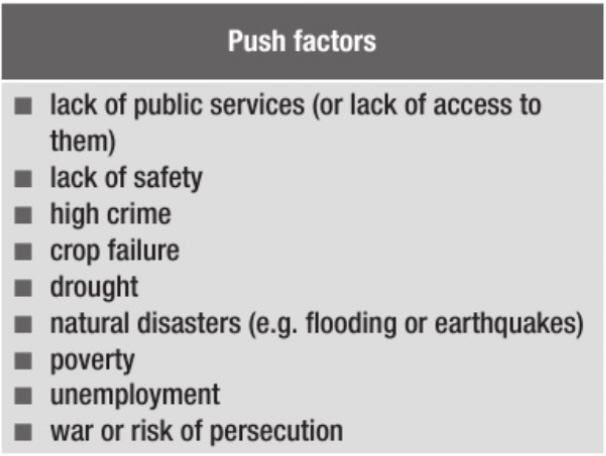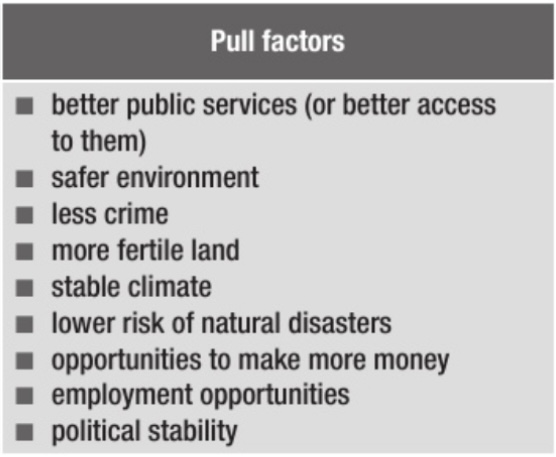Migration: challenges and opportunities
1/15
There's no tags or description
Looks like no tags are added yet.
Name | Mastery | Learn | Test | Matching | Spaced |
|---|
No study sessions yet.
16 Terms
Migrants
People who travel to different country or place, often in order to find work or better living conditions
Reasons for migration: 4 types
Economic, social, political and environmental
Economic migration examples
Employment opportunities (e.g Spain has one of the highest unemployment rates among EU countries so young people often travel elsewhere) (Internal migration — rural to urban areas = Spain donut)
Higher wages (many Spaniard nurses migrated to the UK, Norway, Ireland)
Social migration examples
Better quality life (standard of living)
Public services (services offered or controlled by government in areas important for quality of life above profit motive —social welfare) like healthcare (public healthcare —free), education, infrastructure (traffic control, roads), law enforcement
Inside public services we have social services that aim to support basic needs of individuals and communities like child welfare, disability services
Closer to family and friends to establish a support network
Political migration examples
Escape political persecution or war (refugees —officially recognised as needing protection)
Asylum seekers (seeking protection in another country and is waiting to be recognised as a refugee): international law for the right to seek asylum (article 14 of the UDHR)
Examples of refugees: Ukrainians (war) to Poland/Romania/Moldova, Syrians (civil war) to Lebanon/Turkey/Jordan
Environmental migration examples
Escape natural disasters like flooding, earthquake, desertification driven by climate change impacts like drought and sea levels rise
In future more migration due to environment (droughts/desertification less food; floods/sea levels rise so more homes destroyed)
Coastal areas in for example Pacific islands vulnerable to rise in sea levels.
Droughts in Central America (regions like Guatemala and Honduras) drive migration to US
Push factors
High levels of crime = in Venezuela crime is a significant factor driving migration

Pull factors

Positive impact on host countries
Enriched by cultural diversity
Globalisation: cuisine (chefs from other places), entertainment
More young-abled workers who pay taxes (pension gap can be filled)
Spain has a large population of old people so immigrant are important to fill pension gaps
Job vacancies and skill gaps can be filled
Usually immigrants (from less developed countries) take jobs locals don’t want. For example, a significant portion of the agricultural workforce in US (about 40%) are Mexicans.
Economic growth can be sustained
Increased labor force and innovation as immigrants often bring with them new skills which can lead to increased productivity
Japan is notorious for not receiving many immigrants so it’s economy is static
Negative impacts on host countries
Increases in population puts pressure on public services
increased demand for healthcare, education, housing, transport
Racial, religious, ethnic tensions → violence
Job competition which can lead to depression of wages especially in lower paying jobs
some local workers may be displaced by migrants who accept lower wages
In low-skilled sectors, wages can be suppressed, which may lead to exploitation
Housing shortages → higher rents and overcrowding in cities
Positive impact on the country of origin
When workers leave, unemployment rates lower
Remittances
Migrants often send money to their families back home. These remittances can significantly boost household incomes, reduce poverty and support local economies.
In some countries remittances make up a large part of GDP (e.g Tajikistan 39% of its GDP)
Returning migrants bring savings, skills, contacts and work experience that can help develop local businesses or services (or have enough to send children to school)
Transfer of ‘democratic values’
Negative impacts of migration in country of origin
Brain drain
Skilled workers like doctors, engineers, entrepreneurs often leave for better opportunities abroad. This can weaken essential services and slow development.
Labour shortages
If many people in the working age migrate, especially young adults, it can create gaps in the workforce, especially in farming or manual jobs + loss of money from taxes to pay pensions and public services.
Family separation
long-term separation from parents or spouses can cause emotional stress and social issues especially for children
Loss of open minded citizens. If they leave, it could lead to greater support to, for example dictatorships
Overdependence on remittances
Some countries become too dependent on money sent from abroad. This doesn’t allow economic growth or development in their own economy. If migration slows or remittances drop (e.g during COVID-19), it can hurt national income (e.g Philippines — remittances, a vital source of income for many Filipino families decreased by 2-3% in 2020)
China and India, despite receiving a large amount of remittances, are not dependent, because they have large, diverse economic sectors and large populations
China — manufacturing, tech
India — agricultural sector, growing service industry, manufacturing
Remittances
Amount of money earned by a migrant worker in one country and sent back to their own country
With the advancement of technology, remittances are easier to send. Why is this a good thing?
Platforms like Remitly offer faster, cheaper (reduced fees) and more convenient ways to send money.
People no longer have to pay enormous amounts (to bank or money transfer services/companies) or do it illegally (through envelopes/cash, which could get lost or stolen)
Remittances can be more than just money. They can be of social/cultural nature. What does this mean + examples of what might this be?
Social/cultural remittances are ideas, behaviours, values and knowledge that migrants bring back home
Sharing modern farming techniques
Promoting democratic values
Introducing new attitudes towards education or gender roles
New cuisines or fashion
Celebrating international holidays
Music, language influence or media
In which type of countries are remittances along with ____ act as one of the largest financial inflows?
Blank - international aid
Developing countries